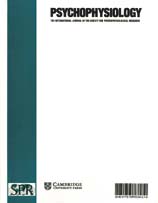Crossref Citations
This article has been cited by the following publications. This list is generated based on data provided by
Crossref.
Cycowicz, Yael M.
and
Friedman, David
1999.
The effect of intention to learn novel, environmental sounds on the novelty P3 and old/new recognition memory.
Biological Psychology,
Vol. 50,
Issue. 1,
p.
35.
Divenyi, Pierre L.
and
Simon, Helen J.
1999.
Hearing in aging: issues old and young.
Current Opinion in Otolaryngology & Head and Neck Surgery,
Vol. 7,
Issue. 5,
p.
282.
Kok, Albert
1999.
Varieties of inhibition: manifestations in cognition, event-related potentials and aging.
Acta Psychologica,
Vol. 101,
Issue. 2-3,
p.
129.
Ranganath, Charan
and
Paller, Ken A.
1999.
Frontal Brain Activity during Episodic and Semantic Retrieval: Insights from Event-Related Potentials.
Journal of Cognitive Neuroscience,
Vol. 11,
Issue. 6,
p.
598.
Kimble, Matthew
Kaloupek, Danny
Kaufman, Milissa
and
Deldin, Patricia
2000.
Stimulus novelty differentially affects attentional allocation in PTSD.
Biological Psychiatry,
Vol. 47,
Issue. 10,
p.
880.
Hozumi, Akinori
Hirata, Koichi
Tanaka, Hideaki
and
Yamazaki, Kaoru
2000.
Perseveration for novel stimuli in Parkinson's disease: An evaluation based on event-related potentials topography.
Movement Disorders,
Vol. 15,
Issue. 5,
p.
835.
Kok, Albert
2000.
Age-related changes in involuntary and voluntary attention as reflected in components of the event-related potential (ERP).
Biological Psychology,
Vol. 54,
Issue. 1-3,
p.
107.
Jeon, Yang-Whan
and
Polich, John
2001.
P3a from a passive visual stimulus task.
Clinical Neurophysiology,
Vol. 112,
Issue. 12,
p.
2202.
Heinrich, H
Moll, G.H
Dickhaus, H
Kolev, V
Yordanova, J
and
Rothenberger, A
2001.
Time-on-task analysis using wavelet networks in an event-related potential study on attention-deficit hyperactivity disorder.
Clinical Neurophysiology,
Vol. 112,
Issue. 7,
p.
1280.
Friedman, David
Cycowicz, Yael M.
and
Gaeta, Helen
2001.
The novelty P3: an event-related brain potential (ERP) sign of the brain's evaluation of novelty.
Neuroscience & Biobehavioral Reviews,
Vol. 25,
Issue. 4,
p.
355.
Fingelkurts, Alexander A.
Fingelkurts, Andrew A.
Krause, Christina M.
and
Sams, Mikko
2002.
Probability interrelations between pre-/post-stimulus intervals and ERD/ERS during a memory task.
Clinical Neurophysiology,
Vol. 113,
Issue. 6,
p.
826.
Opitz, Bertram
2003.
Detection of Change.
p.
117.
Polich, John
2003.
Detection of Change.
p.
83.
Polich, John
and
Comerchero, Marco D.
2003.
P3a from Visual Stimuli: Typicality, Task, and Topography.
Brain Topography,
Vol. 15,
Issue. 3,
p.
141.
Gaeta, Helen
Friedman, David
and
Hunt, Gregory
2003.
Stimulus characteristics and task category dissociate the anterior and posterior aspects of the novelty P3.
Psychophysiology,
Vol. 40,
Issue. 2,
p.
198.
Ranganath, Charan
and
Rainer, Gregor
2003.
Neural mechanisms for detecting and remembering novel events.
Nature Reviews Neuroscience,
Vol. 4,
Issue. 3,
p.
193.
Dien, Joseph
Spencer, Kevin M.
and
Donchin, Emanuel
2003.
Localization of the event-related potential novelty response as defined by principal components analysis.
Cognitive Brain Research,
Vol. 17,
Issue. 3,
p.
637.
Legrain, Valéry
Bruyer, Raymond
Guérit, Jean-Michel
and
Plaghki, Léon
2003.
Nociceptive processing in the human brain of infrequent task-relevant and task-irrelevant noxious stimuli. A study with event-related potentials evoked by CO2 laser radiant heat stimuli.
Pain,
Vol. 103,
Issue. 3,
p.
237.
Kiehl, Kent A.
and
Liddle, Peter F.
2003.
Reproducibility of the hemodynamic response to auditory oddball stimuli: A six‐week test–retest study.
Human Brain Mapping,
Vol. 18,
Issue. 1,
p.
42.
Lindı́n, Mónica
Zurrón, Montserrat
and
Dı́az, Fernando
2004.
Changes in P300 amplitude during an active standard auditory oddball task.
Biological Psychology,
Vol. 66,
Issue. 2,
p.
153.

